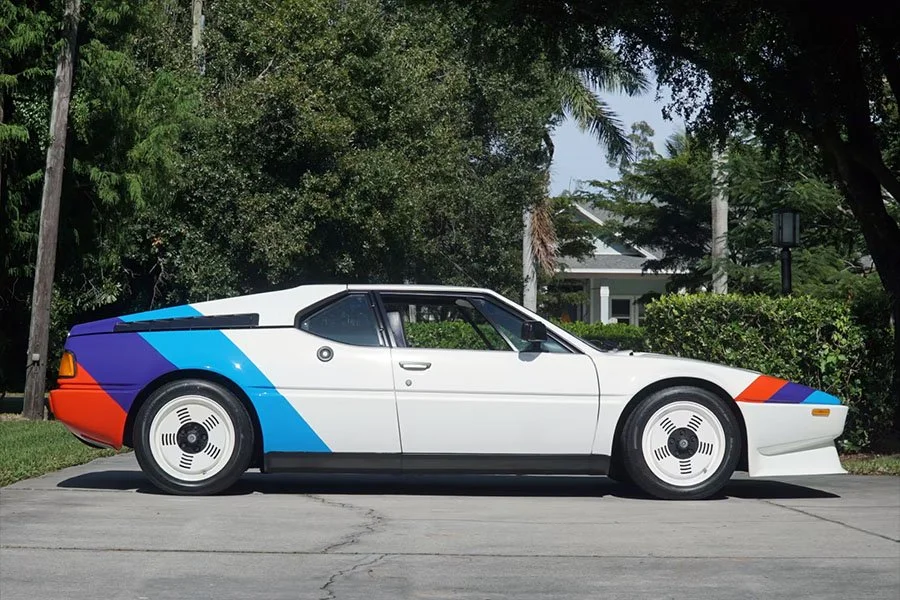Guide: BMW Art Car #1 - BMW 3.5 CSL 'Alexander Calder'
/BACKGROUND
The idea for BMW’s now legendary line of Art Cars originally came from outside the company; it was young French auctioneer, Herve Poulain, that suggested the concept as a means of combining his two passions – art and speed.
Poulain was among the first auctioneers to preside over classic and collectable car sales. In 1973 he also published the seminal work L’Art et l’Automobile.
Poulain mooted his Art Car concept in early 1975 and found support from the head of BMW Motorsport, Jochen Neerpasch. Poulain suggested BMW should supply a car that he could have decorated by an eminent contemporary artist. To garner maximum publicity, the machine would then be raced at the Le Mans 24 Hours.
BMW’s PR department got behind the idea and Poulain was promised an E9 CSL if he could come up with a suitable proposal.
BMW E9 CSL
BMW Motorsport had raced the Group 2 CSL extensively in its debut season (1973). A drastically reduced programme was run in 1974 before the works team returned with an uprated model to contest the 1975 IMSA GTO Championship in the USA. Broadly similar cars were campaigned in Europe by BMW’s satellite teams.
With the news that one of the spare IMSA cars would be provided for the 1975 Le Mans race if an artist could be found for the project, Poulain turned to his friend, the renowned sculptor, Alexander Calder.
Armed with a CSL model bought from a toy shop, Poulain headed to Calder’s home in the South of France. Over lunch a deal was struck and Poulain returned to Munich with the good news.
ALEXANDER CALDER
Born into a family of artists in Pennsylvania in 1898, Alexander Calder’s father and grandfather were both sculptors and his mother was a professional portrait artist.
Although he worked on sculptures from an early age, Calder’s parents did not want him to become an artist so he decided to study mechanical engineering instead.
Despite his gift for maths, after holding a number of different engineering jobs, Calder decided to move to New York and pursue a career as an artist. He enrolled at the Art Students League and, three years later (in 1926), moved to Paris and joined the Academie de la Grande Chaumiere.
Calder simultaneously established his own studio and befriended a number of avant garde artists including Fernard Leger, Jean Arp and Marcel Duchamp.
In addition to his sculptures, Calder began to make mechanical toys, wire sculptures and abstract mobiles that were variously given motion by motors and airflow.
Calder’s unique creations quickly garnered attention and he had his first solo show in 1929. By the mid 1930s, he was creating enormous works that were hailed as the most innovative American scuptures of the 20th century. Despite their imposing size, Calder’s often monumental pieces were nevertheless light and buoyant in appearance.
Having returned to America in 1933, Calder moved back to France in 1956.
In addition to sculptures, Calder painted throughout his career. Common themes were animals, figures and geometric shapes.
The BMW CSL was not Calder’s first vehicular commission. In 1973, he had painted a Douglas DC-8 dubbed Flying Colors for Braniff International Airways.
CALDER’S CSL
As was the case with much of his work, Calder covered the BMW using primary colours and graceful sweeping curves. The attractive livery gave the impression the car was moving; it instantly became a hit with race car fans and art critics alike. In many ways the CSL perfectly summed up Calder’s approach to his art:
“I want to make things that are fun to look at, that have no propaganda value whatsoever."
1975 LE MANS 24 HOURS
The stunning CSL was entered for Herve Poulain, Sam Posey and Jean Guichet to drive at the 1975 Le Mans 24 Hours. It ran in the Touring class and caused a sensation. Calder was on hand to see his work premiered.
Powered by a 3.2-litre DOHC straight six with four valve heads and 480bhp, Posey qualified the CSL (which was insured for DM1m or $430,000) in tenth position. It was easily the fastest Touring car in attendance and went quicker than any of the GT cars as well.
Posey was up to seventh at the end of the first lap, but soon found himself in the pits for a blocked fuel valve to be cleared.
Having lost a lap, Posey went back out and, after two hours, the BMW was ninth.
With three hours gone, Posey was up to sixth and, as 8pm approached, the CSL had moved into fifth.
However, shortly before 9pm, a CV joint failed and the CSL was stranded out on the circuit.
The BMW subsequently returned to Munich and was retained for display use.
It was one of Alexander Calder’s final works before he died unexpectedly of a heart attack in New York in November 1976.
Text copyright: Supercar Nostalgia
Photo copyright: BMW - https://www.bmw.com

































